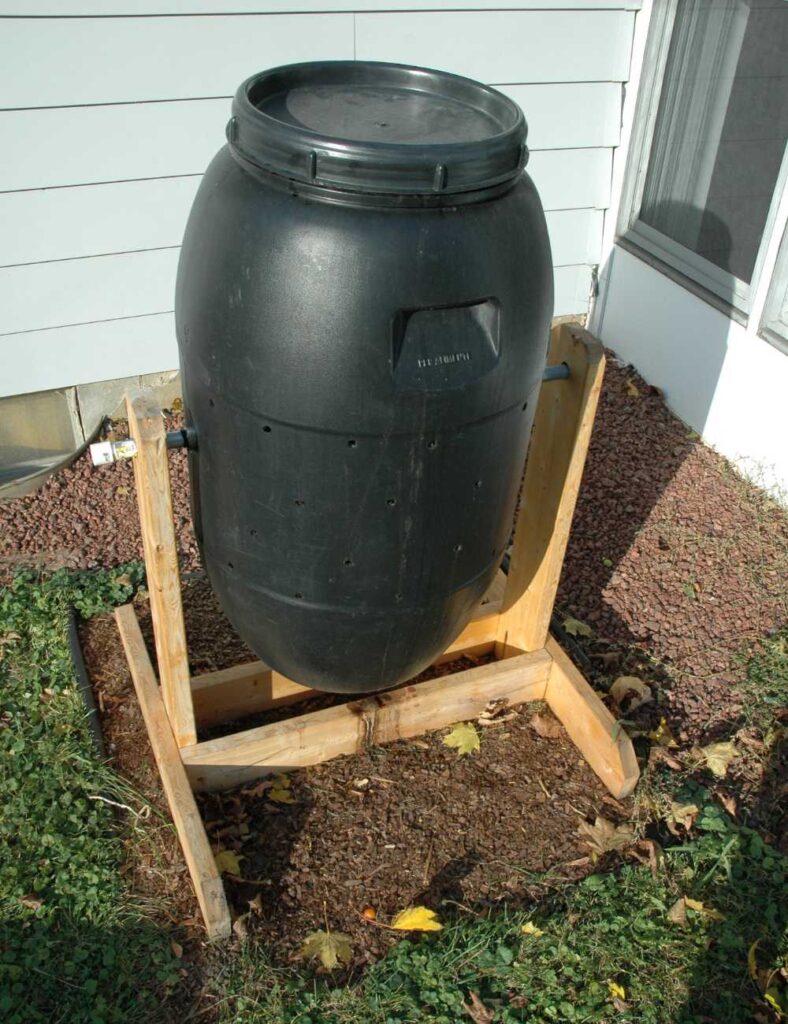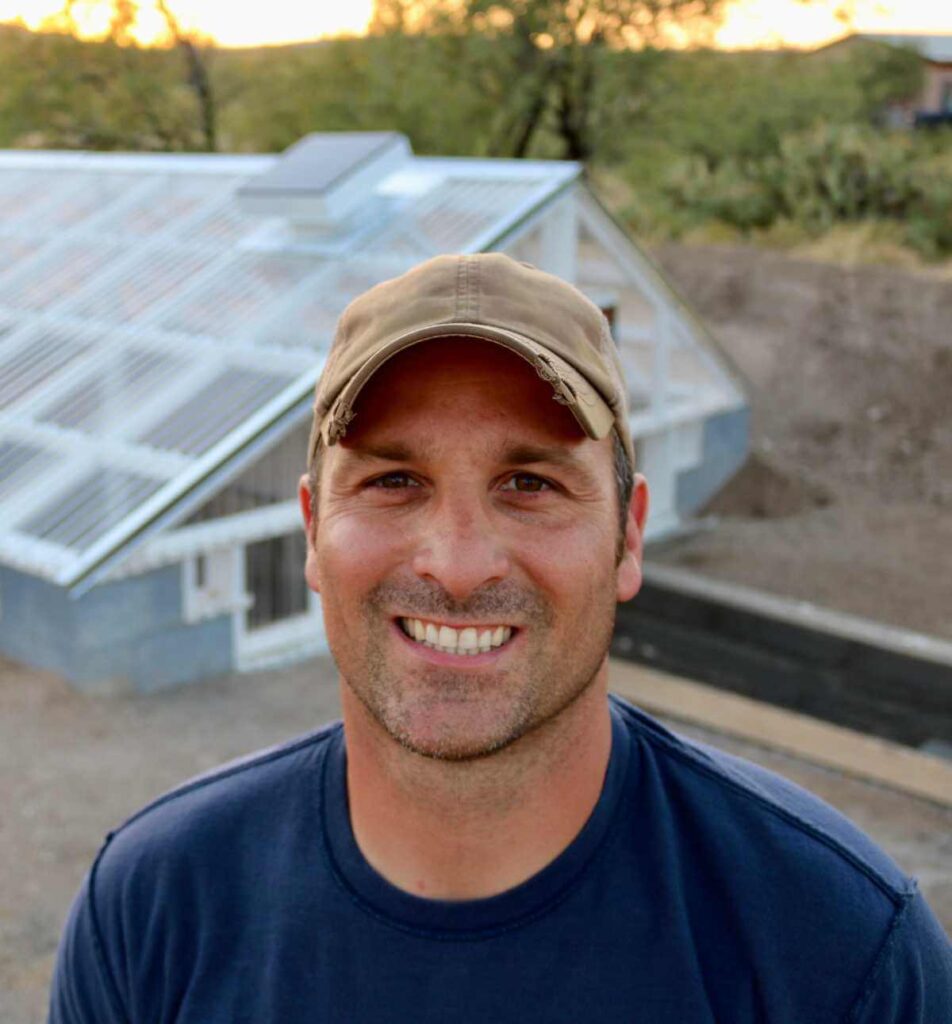This post was last updated on February 4th, 2023 at 02:22 pm
Building a compost bin from a 55-gallon plastic drum doesn’t take special skills. But I have a knack for turning seemingly easy projects into complicated ones. So, as I searched the internet last summer for a how-to video on the subject, my top priority was to find one that featured a simple design and clear instructions. Thankfully, I found exactly that at a YouTube channel called Homesteadonomics. As I browsed its large video collection, I realized the compost bin represented a tiny fraction of the projects undertaken by the channel’s creator, Joe Mooney.
“What doesn’t this guy know how to do?” I wondered.
Welcome to Homesteadonomics 101
From making soap, to fixing knife handles, to creating a rainwater collection system, to constructing a sunken greenhouse and much more, the range of Joe’s skills is mind-boggling. Joe started Homesteadonomics nearly 10 years ago, while he says he became “more serious” about it over the past 6 years or so. Amazingly, the channel is not his full-time job. He works as a firefighter and spends his off days doing DIY projects.
Joe is currently about to sew his own backpack for a hiking trip. His plans also include redesigning a firefighting trailer, which comes in handy near his rural Arizona home where wildfires are a threat. His most pressing priority, however, is preparing for the arrival of a new goat.
“We’re getting a buck two days from now, and I don’t quite have his yard completed. We have 100% rain in the forecast right now, so this afternoon I’ll be working in the rain, which is fine,” he told Frugalmatic during a Jan. 16 interview. “Because if you get rain in the desert, you have to be thankful for it. And we’ve been having a lot of good rains recently.”
Joe is an inspiration to the rest of us aspiring to expand our DIY skills. He told me he’s not afraid to call in professionals when necessary, but he does prize self-reliance. “I get a lot of personal satisfaction out of just being able to do for myself. The benefit of that is you end up with a little extra skill and a little extra confidence,” Joe said.
Plus, self-reliance acts like an insurance policy in the event of an economic disruption. A lesson we learned from the COVID-19 pandemic is that supply chains are fragile. It doesn’t take much to flip the societal switch from order to chaos.
“We live in pretty much the most comfortable time in world history that I know of. If there was ever a breakdown, it might be wise to know a little bit how to do things for yourself,” Joe said.
Becoming more self-reliant—Homesteadonomics style
I asked Joe what he might recommend for people wanting to become more self-reliant. This is his advice: “If you’re wanting to get into a more self-reliant lifestyle, pick a multifaceted project that will allow you to, No. 1, give your life some redundancy; No. 2, help you build skills; and, No. 3, give you a tangible benefit for the future.”
Building a chicken coop and raising chickens can be a good starter project. (You’ll want to check with your local government to see whether they allow chickens.) “I guarantee you, a person who builds a chicken coop is going to be better at doing any number of projects after building a chicken coop than before,” Joe said.
But if chickens don’t appeal to you (or it’s just not practical), there are many other ways you can practice self-reliance. Browse through the list of Homesteadonomic videos for more ideas. You’ll likely find something to suit you.

Read more excerpts from my interview with Joe Mooney below. Responses have been edited for length and clarity.
Frugalmatic: Where do you find the time for your projects? What is your time management secret?
Joe Mooney: I wish I had a secret. I tend to be a slow starter and real strong at midpoint to finishing up a project. I’m very much a night owl, even though I wake up every day at 6:30. I basically develop a lot of my projects as I start them. I might have a few sketches on paper, just a few rough ideas. But I’m very much a figure-it-out-as-I-go kind of person. And, pertaining to time, with my firefighter job, I work 24 hour shifts. So after 5 days of doing those 24 hour shifts, I get four days off in a row. When I have those larger breaks, even if we have a really busy shift and I have to sleep several hours of that first day of my four-day break, I still have two-and-a-half to three solid days that I can work on stuff.
F: I like how you highlight both your successes and struggles in your videos. It’s a reminder that do-it-yourself projects aren’t always easy. How do you overcome the inevitable frustrations, especially when a project starts to take more time than you might have anticipated?
JM: That’s one of those things that, just like life, happens to everybody. A lot of my projects are a little bit out of the norm, a little bit alternative, like my travel trailer and sunken greenhouse. I very much gravitate to things that aren’t super common. As far as running into failures, I run into those a lot. I’ve gotten better over the years. I’m now in my early 40s. When I was working on projects in my early 20s, I would have the same amount of frustration, but I would let it get to me a lot more.
Now I tend to take a step back when I have a setback like that. I usually ask myself, “OK, how can I make it work with what I have? Is there a way to modify the project? Can I adapt on the go and perhaps work on something really interesting?” Constraints on things are often where people get really inventive ideas. Sometimes when you have a completely blank canvas, you can do anything.
Enjoying this interview? Check out the complete archive
F: Some of what you’re talking about is having the right expectation going into a project. I feel like when I’ve been the most frustrated, I’ve expected things to take a certain amount of time and to go a certain way.
JM: Inevitably, if you’re doing something that is a little bit oddball or involves a new skill, it’s going to take longer. Five to 10 years ago, I was very much an optimist on time. Now I overestimate the time it’s going to take me. If I think something’s going to take me two days, I’ll tell my wife, “I think I can get this done in four days.” That way, it keeps me on track, giving me a little buffer time.
F: Out of all your projects, which one has been the most satisfying to do and why?
JM: It’s the ones that really challenge me. Specifically, the one that comes to mind that is probably my favorite overall is my travel trailer project. When we go on our camping trips in the travel trailer and I lay down to go to bed at night, and my wife and daughter will usually fall asleep quicker than me, I’m just looking around and thinking, “Man, I built this.”
And it’s also associated with our family vacations, which are pretty important to me. It’s just that satisfaction of, “Wow, this was such a big project, and it’s all been working out. And I get to enjoy it every time we get to go on a camping trip.” I grew up camping; my wife grew up camping. So those vacations are already a little extra special. We’ll go camping with two, three, four other families, and my daughter plays with her cousins. And we go fishing, and play corn hole and meadow golf. It’s just got a lot of stuff that supports it being my favorite project because it brings us to our super happy moment as a family.


Hi,
I am from Jamaica in the Caribbean. It’s my first time reading your article and I am very impressed and interested. I do recycling. I love to organize, reorganize and sort things. I believe in the proper storage of items.
I spend most of my time outdoors. I love nature. I have small fruit trees and gardens.
I like to create things and repurpose stuff. So I eagerly look forward to tips from you guys. All the best on your projects.
Cheers!